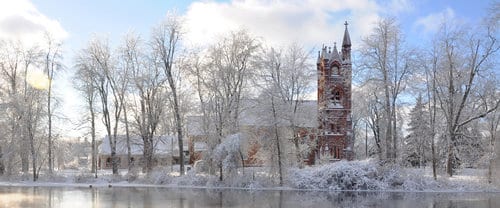It was a brutal winter to remember for much of the Northeast United States and New England, with bitter cold and snowstorm after snowstorm—ironic considering it was Earth’s warmest winter on record. Seventeen years ago the small town of Potsdam (pop. 9,700) in northern New York similarly braced against sleet, snow, and freezing rain that paralyzed the community.
Located along the banks of the Racquette River near the Canadian border and home to both SUNY Potsdam and Clarkson University, Potsdam was the epicenter for a 1998 ice storm that left 130,000 people in the region without power. Some people lost power for up to three weeks, and the storm was ranked the deadliest and costliest weather event in the region’s history up to that point, only to be surpassed by Superstorm Sandy fourteen years later.
Now, National Grid (Potsdam’s utility provider), General Electric, Clarkson University, and the National Renewable Energy Laboratory (NREL) are partnering to make sure severe weather events like the 1998 ice storm and Superstorm Sandy won’t have such drastic effects again, by building what could be the nation’s largest municipal microgrid.
The microgrid idea began as a research project in Clarkson University’s electrical engineering program. Folks from Clarkson, GE, Nova Energy Specialists, and National Grid got together to analyze how a community might sustain an energy system over a short period of time in case of a catastrophe.
“I was deployed to Sandy for a week to help with the response and relief effort,” says National Grid spokeswoman Virginia Limmiatis. “It was complete and utter devastation. Not just a lack of electricity, but fuel, food, and all the basic needs we take for granted. With this microgrid project we want to look at every aspect of a family’s life and help them weather the storm.”
NO LONGER YOUR GRANDFATHER’S UTILITY
The microgrid will use local renewable resources as much as possible. The proposal calls for 3 megawatts (MW) of combined heat and power generators, 2 MW of solar PV, 2 MW of storage, and 900 kW or more of hydropower, which can be challenging on many levels. “Building and operating a microgrid tends to challenge almost every traditional role or precedent for the utility, for the state regulatory commission, and for the community,” says Leia Guccione, a manager in RMI’s electricity practice. “Microgrids not only operate differently from a technical standpoint, they also require new regulatory policies and new financing mechanisms.”
While some utilities may feel threated by microgrids and/or renewable generation, National Grid welcomes it. “National Grid takes energy efficiency and renewable energy very seriously,” according to Limmiatis. “We understand that the utility model is changing, and that this is no longer your grandfather’s utility.”
In fact, National Grid has launched an initiative called Connect21 to create a more customer-centric, resilient, agile, efficient, and environmentally-sound energy network. The utility plans to invest $10 billion in infrastructure over the next five years to reach this goal. Connect21 aligns with New York’s Reforming the Energy Vision (REV) initiative to modernize the state’s electricity system and promote energy efficiency, renewable energy technologies, and wider deployment of distributed energy resources, such as microgrids, on-site power supplies, and storage.
WIN-WIN SITUATION
A $1.2 million grant from the DOE’s Office of Electricity Delivery and Energy Reliability and a $300,000 investment from GE will be used to develop an enhanced microgrid control system (eMCS). The control system will keep the town’s electricity on for several days if the main power station goes down, and will also help National Grid better integrate distributed energy resources into the grid. The microgrid will normally operate in a grid-connected mode. The eMCS will also be used to maximize the operating revenue of any individuals who have their own distributed generation systems. While studies are still being conducted, the hope is that during an extreme event when the main grid goes down, the microgrid will operate in island mode and use energy storage to help power essential services for up to two weeks. These services include SUNY Potsdam, Clarkson University, and critical municipal and emergency facilities such as local police, fire, hospital, potential shelter locations, and water/sewer facilities.
Besides the diversity of the generation sources, another key factor to withstanding the common ice storms of the area is putting the microgrid distribution lines underground. Clarkson University is designing the underground microgrid—to be built in parallel to the existing grid—with a $381,000 grant from the New York State Energy Research and Development Agency (NYSERDA). The total installed cost of the microgrid is not yet determined, nor is the new rate structure that will be needed.
With 18 months of engineering and design, and 6 months of testing the microgrid with NREL, completion of the actual underground microgrid in Potsdam is years out. However, Sumit Bose, GE’s lead researcher for the project, is optimistic that the microgrid will have far-ranging impacts.
“GE’s control system, and the underground microgrid envisioned for the Potsdam community, could serve as a model for towns and cities across the country that are susceptible to weather disasters and blackouts,” Bose said in a press release about the project. The Potsdam microgrid will not only keep the lights on in this northern New York town during severe weather, but signifies a new collaborative approach between utility companies and renewable energy providers which will hopefully be the model of the future. Adds RMI’s Guccione: “Across the United States, communities are looking to microgrids as a mechanism to make their energy infrastructure more resilient and dynamic, making the entire community more resilient by extension. RMI has worked with over a dozen communities doing exactly this in only the past two years. The appetite for clean, local, reliable energy solutions is definitely growing.”
Source: RMI. Reproduced with permission.









